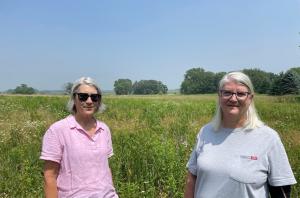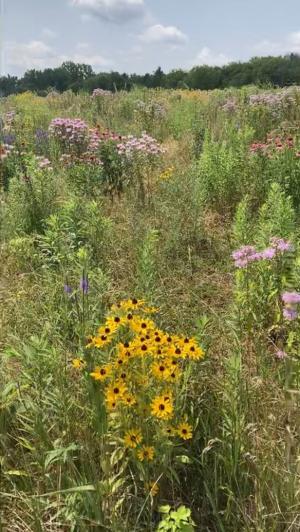Giving the Land Back to Nature

After attending a Pollinator Field Day event, Leslie Meyer of Hideaway Farm decided to “bring back the balance of nature and give something back” by converting fourteen acres of her land to a native prairie planting habitat for pollinators and wildlife with help from her local NRCS service center.
Background

“Thank you for planting this,” Leslie Meyer of Winnebago County has heard from several neighbors over the past few years, referring to the fourteen acres of pollinator habitat that she maintains on Hideaway Farm in Pickett, Wisconsin. Leslie didn’t have a background in conservation, but first became interested in pollinators and their habitat after listening to a talk show on Wisconsin Public Radio.
That inspired her to attend a Pollinator Field Day entitled “Little Walk on the Prairie,” organized by Merrie Schamberger, a Resource Conservationist with the U.S. Department of Agriculture (USDA) Natural Resource Conservation Service (NRCS) Oshkosh Service Center and hosted on a local farm, where she met other farmers who had shared their success and encouraged her to plant native habitat to support pollinators. Though she was grateful for the thirty years of hay, corn, and alfalfa rotations that was previously farmed on her property, Leslie recalled thinking eagerly on this new venture for the future of her land, “let’s rest it - put it back to nature.”

Highlights
With the help of NRCS, Leslie received financial and technical assistance through the Environmental Quality Incentives Program (EQIP). Merrie and the NRCS Oshkosh staff were able to provide even more information about the process and the benefits of creating habitat for pollinators and helped create a plan to convert fourteen acres of Leslie’s land to dedicated pollinator habitat. Six of those acres already had existing resources and plants suitable for pollinators, so Merrie decided management alone would be best for maintaining those acres. The other eight acres of hayfield would be prepped and seeded with a native conservation cover using a seed mix designed specifically with pollinators in mind. Merrie selected wildflowers with successive bloom times so there would always be something flowering from early summer through late fall. This helps ensure native pollinators have access to food resources all season long, which is an important component of supporting healthy pollinator populations. It also makes for a beautiful prairie that Leslie, and passers-by, get to appreciate all growing season long.
Leslie recalls how Merrie helped her find reputable contractors and seed sources and was supportive throughout the entire process. Merrie continues to be a source of information and feedback as she returns for field visits to evaluate how the pollinator planting is looking and to offer management recommendations.
Future Plans
Leslie plans to maintain her fourteen acres of pollinator habitat well into the future. When asked why conservation is important to her, Leslie maintains her goals of bringing back the balance of nature and giving something back. She encourages people who are interested in doing something on their own land to give it a go. “You don’t need a lot of space. Just do it, even if it’s just your backyard.” Leslie hopes that her habitat is an inspiration to others and that they will consider it for their land too. She has noticed a change over the years in farmers taking more initiative to take care of the land, “[they are] farming smarter, more economically, and taking great pride in what they do.” Leslie hopes that will translate into more farmers and landowners doing what she did.
Merrie continues to check in with Leslie to see how things are going and help monitor the habitat for management needs. There are some areas where non-native grasses are beginning to get a foothold, so future management will include creating a plan for prescribed burns to set back the non-native grass encroachment and encourage the native plant species in those areas. For others who are thinking of creating pollinator habitat on their land, Merrie encourages people to, “talk to other people who have done this before - establishing pollinator habitat takes time.” Setting expectations is important, as a seeded project often shows best by the third year. Seeded in spring of 2020, Leslie’s native conservation cover planting is now rich with many species of native wildflowers in full bloom, attracting pollinators and other wildlife. It takes time for the native plants to establish before they reach maturity and flower, but it is worth the wait – just check with Leslie, her neighbors, or the new flutter of pollinators that found home on Leslie’s land.

Additional Information
Environmental Quality Incentives Program - Wisconsin
The Environmental Quality Incentives Program (EQIP) provides financial and technical assistance to agricultural producers and non-industrial forest managers to address natural resource concerns.
Learn More
